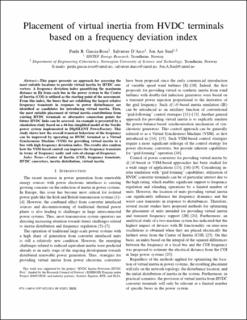| dc.contributor.author | Garcia Rosa, Paula Bastos | |
| dc.contributor.author | D'Arco, Salvatore | |
| dc.contributor.author | Suul, Jon Are Wold | |
| dc.date.accessioned | 2022-04-07T07:38:04Z | |
| dc.date.available | 2022-04-07T07:38:04Z | |
| dc.date.created | 2021-08-10T12:42:45Z | |
| dc.date.issued | 2021 | |
| dc.identifier.isbn | 978-1-6654-3597-0 | |
| dc.identifier.uri | https://hdl.handle.net/11250/2990369 | |
| dc.description.abstract | This paper presents an approach for assessing the most suitable locations to provide virtual inertia by HVDC converters. A frequency deviation index quantifying the maximum distance in Hz from each bus in the power system to the Center of Inertia (COI) is utilized as the starting point of the assessment. From this index, the buses that are exhibiting the largest relative frequency transients in response to power disturbances are identified as candidates for introducing virtual inertia. Then, the most suitable placement of virtual inertia contributions from existing HVDC terminals or alternative connection points for future HVDC links can be assessed. An example is presented by a simulation study based on a 44-bus simplified model of the Nordic power system implemented in DIgSILENT PowerFactory. This study shows how the overall transient behaviour of the frequency can be improved by operating an HVDC terminal as a Virtual Synchronous Machine (VSM) for providing virtual inertia to a bus with high frequency deviation index. The results also confirm how the VSM-based control can improve the frequency transients in terms of frequency nadir and rate-of-change-of-frequency. | en_US |
| dc.language.iso | eng | en_US |
| dc.publisher | Institute of Electrical and Electronics Engineers (IEEE) | en_US |
| dc.relation.ispartof | 2021 IEEE Madrid PowerTech | |
| dc.title | Placement of virtual inertia from HVDC terminals based on a frequency deviation index | en_US |
| dc.type | Chapter | en_US |
| dc.description.version | acceptedVersion | en_US |
| dc.rights.holder | © IEEE. Personal use of this material is permitted. Permission from IEEE must be obtained for all other uses, in any current or future media, including reprinting/republishing this material for advertising or promotional purposes, creating new collective works, for resale or redistribution to servers or lists, or reuse of any copyrighted component of this work in other works. | en_US |
| dc.identifier.doi | 10.1109/PowerTech46648.2021.9494763 | |
| dc.identifier.cristin | 1925015 | |
| dc.relation.project | Norges forskningsråd: 268053 | en_US |
| cristin.ispublished | true | |
| cristin.fulltext | preprint | |
| cristin.qualitycode | 1 | |
